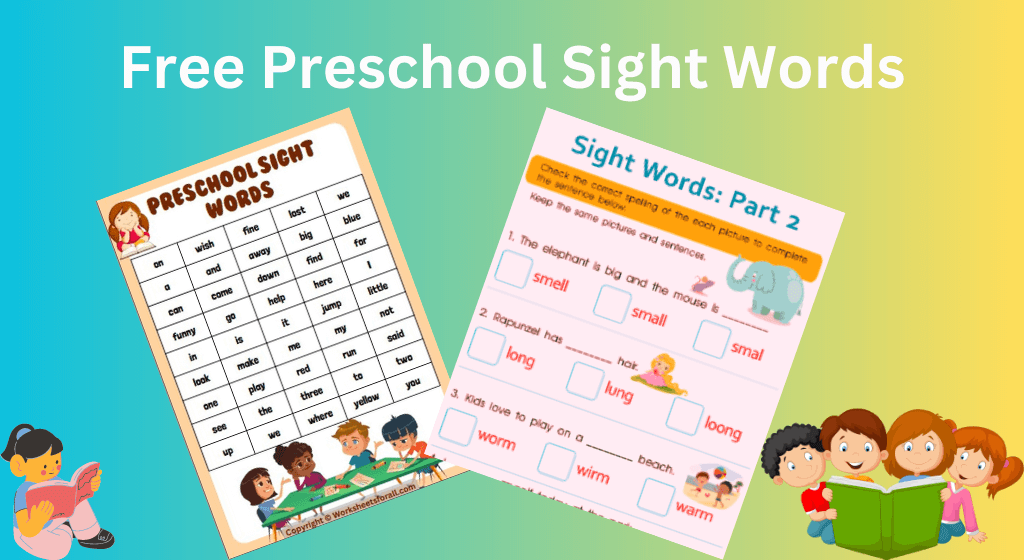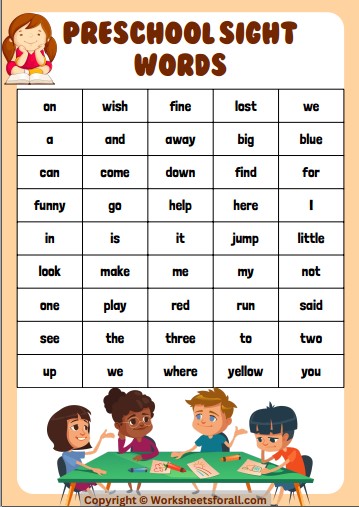Free Preschool Sight Words: The Best Key to Early Learning
Updated: March 14, 2023
272

Welcome to the section Free Preschool Sight Words! This resource is designed to help early readers build a strong foundation in reading through fun and effective worksheets. In this article, we will provide you with a comprehensive list of essential sight words that preschoolers and pre k should know, along with tips and activities for introducing and practicing these words. So, let’s get started and help your little ones become confident and successful readers with kindergarten sight words list printable free available in the section.
Free Preschool Sight Words Worksheets Download
List of Words Preschoolers Should Know
As a parent or educator, it is important to know the essential words preschoolers should know to begin their journey of reading. These words are commonly referred to as sight words, which are words that are recognized instantly without needing to be sounded out.
A list of free preschool sight words for preschoolers may vary depending on the curriculum, but typically includes high-frequency words such as “a,” “an,” “the,” “and,” “is,” “am,” “are,” “was,” “were,” “in,” “on,” “at,” “to,” “of,” “for,” “with,” “you,” “me,” “my,” “he,” “she,” “it,” “we,” and “they.” These words make up a large portion of the English language and are used repeatedly in everyday reading and writing.
Introducing sight words to preschoolers is an important step in their early reading development. By learning sight words, preschoolers can start recognizing words quickly and easily, which allows them to focus on decoding new words and understanding the text they are reading.
Incorporating sight words into preschoolers’ learning activities, such as through games, flashcards, and worksheets, can make the process fun and engaging. It is also important to provide plenty of repetition and reinforcement to help children remember the words and build their confidence in reading.
Having a solid foundation of free preschool sight words is essential for success in reading and writing, which is why it is important to introduce free preschool sight words to preschoolers early on in their education
Kindergarten Sight Words Homework: Fun and Effective Worksheets for Practice
Homework is an important aspect of learning for kindergarten students, as it helps them practice and reinforce the skills they have learned in class. When it comes to free preschool sight words, homework can be especially beneficial. Sight words are high-frequency words that children should be able to recognize quickly and automatically, as they are commonly used in written and spoken language.
Kindergarten sight words homework should be designed to be both fun and effective. Worksheets are a great way to achieve this. They can be engaging and interactive while still providing valuable practice. Worksheets can be tailored to each child’s individual needs, allowing them to progress at their own pace.
When designing kindergarten sight words homework worksheets, it’s important to keep in mind the different learning styles of students. Some children may prefer visual aids, such as pictures or flashcards, while others may prefer auditory aids, such as songs or rhymes. Worksheets that incorporate a variety of learning styles can be the most effective.
It’s also important to make sure that the worksheets are age-appropriate and aligned with the kindergarten curriculum. Kindergarten sight words homework should reinforce the words and concepts that are being taught in the classroom, rather than introducing new material.
Overall, kindergarten sight words homework can be a valuable tool for reinforcing learning and improving reading skills. With fun and effective worksheets, students can practice their sight words in a way that is both engaging and educational.
how to introduce sight words to preschoolers: Tips and Activities for Early Learning
How to introduce sight words to preschoolers is a very common question among parents, as Introducing sight words to preschoolers is an important step in developing their reading skills. After consultation with many teachers, psychologist we have compiled tips and activities to ease the process of understanding free preschool sight words. They need to be memorized and recognized on sight.
Here are those effective tips and activities for introducing sight words to preschoolers:
- Start with simple words: Begin with basic sight words like “the,” “and,” “a,” “to,” and “is.” These words are easy to recognize and use in sentences.
- Use repetition: Children learn best through repetition. Repetition can be in the form of reading, writing, and saying the words multiple times.
- Use multisensory activities: Preschoolers learn best when they can use multiple senses. Use activities like flashcards, games, songs, and writing exercises to help them learn and memorize sight words.
- Incorporate sight words into everyday activities: Encourage children to find sight words in books, signs, and labels in their environment. Make a game of finding and recognizing sight words in everyday life.
- Use technology: There are many sight word apps and games available online that can help preschoolers practice their sight words in a fun and engaging way.
Remember, it’s important to be patient and encourage preschoolers and pre k children as they learn free preschool sight words. With consistent practice and support, they will become more confident readers and writers.
How Many Sight Words Are There? A Comprehensive Guide for Educators and Parents
“How many sight words are there?” is the most asked question among parents and educators who are helping young learners build their reading skills. Sight words are words that children should recognize instantly, without having to sound them out. These words make up a significant portion of the words used in reading and writing, so it’s important for children to learn them early on.
The exact number of sight words can vary depending on the source, but there are generally considered to be around 100-300 sight words that children should know by the end of kindergarten or first grade. These words often include high-frequency words like “the,” “and,” “a,” “to,” and “in,” among others.
While it’s important for children to learn these words, it’s also essential to note that not all kindergarten sight words list printable free are created equal. Some words are more commonly used than others, and some may not be as useful in a child’s reading and writing development. Additionally, the number of sight words a child should learn depends on their age and reading level.
Parents and educators can use a variety of tools and resources to help children learn sight words, such as flashcards, games, and worksheets. By making learning free preschool sight words fun and engaging, children are more likely to retain the information and build their reading skills.
Why Are Sight Words Important in Kindergarten? Free Preschool Sight Words Importance
Why are sight words important in kindergarten is the query which left many parents and educators perplexed. The simple answer to this query is that learning sight words is an essential aspect of developing strong reading skills in kindergarten. These words are critical for building a strong foundation in reading, and they play a significant role in children’s success throughout their academic careers.
In kindergarten, students typically learn to read and write a set of about 50 sight words. These words are chosen because they appear frequently in children’s books and other written materials, making them essential for reading comprehension. Examples of common free preschool sight words for kindergarteners include “the,” “and,” “is,” “in,” “he,” “she,” and “said.”
Teaching sight words is important because it helps students read more fluently and with greater comprehension. Sight words provide a bridge between decoding words and reading fluently, allowing students to focus on understanding the text they are reading. When children know kindergarten sight words list printable free automatically, they can read more quickly and with more confidence, which can improve their overall reading ability.
Additionally, free preschool sight words are important because they provide a foundation for learning more complex vocabulary and grammar rules. Children who struggle with sight words often have difficulty understanding the meaning of sentences and paragraphs, which can lead to problems with comprehension and written expression.
Overall, the importance of sight words in kindergarten cannot be overstated. By building a strong foundation of sight word recognition, children are better equipped to succeed in reading and throughout their academic careers.
When to Introduce Sight Words in Kindergarten: Best Practices and Strategies for Success
Introducing sight words to kindergarten students is a critical step in their early reading development. As educators and parents, it is essential to know when and how to introduce sight words effectively.
The best time to start introducing sight words to kindergarten students is during the first few weeks of school. During this time, students are typically learning letters and their corresponding sounds, which will help them decode sight words. It is important to begin with a small set of sight words, typically between 5-10, and gradually add more as students become more proficient in recognizing and reading them.
Several strategies and activities can make the learning process fun and engaging. Teachers can use flashcards and games, such as sight word bingo or memory matching, to help students learn and recognize sight words. It is also essential to incorporate free preschool sight words into daily reading and writing activities as it provides students with opportunities to practice and apply what they have learned.
Remember that every student learns at their own pace, so it is crucial to provide patient and individualized support as needed. Celebrate student progress and achievements, no matter how small they may seem. With consistent practice and support, teachers can help kindergarten students develop a strong foundation in sight words and reading, setting them up for success in their academic careers.
Why Learn Sight Words? Reason for Learning Free Preschool Sight Words
Learning sight words is important for kids who are just starting to read. Sight words are words that are commonly used in written text, and they don’t follow regular phonics rules, so kids need to learn them by sight. When kids know these words, they can read more smoothly and quickly, which helps them to understand what they’re reading better.
For example, imagine trying to read a sentence like “The cat sat on the mat” without knowing the words “the” and “on”. It would be hard to figure out what the sentence means! But if a child knows these words by sight, they can read the sentence easily and quickly.
So, learning free preschool sight words helps kids become better readers and understand what they’re reading more easily. It’s an important step in learning to read!
FAQS For Free Preschool Sight Words
How to introduce sight words to preschoolers?
Use flashcards with pictures and sentences, play games, make sight words a part of your daily routine, and keep it fun and positive.
How many sight words are there?
There is no definitive list, but most sight word lists contain around 100-300 words that are commonly used in written texts and are difficult to sound out using phonics rules. Some examples of common sight words include “the,” “and,” “a,” “to,” “in,” “is,” “that,” “of,” and “it.”
Why are sight words important in kindergarten?
Sight words are important in kindergarten because they help children develop their reading skills and become more confident readers. By learning sight words, children can read more quickly and efficiently, and better understand the meaning of the text they are reading.
When to introduce sight words in kindergarten?
Sight words can be introduced in kindergarten as soon as children start to learn how to read, typically after they have learned basic phonics skills. Teachers and parents can start with a small set of high-frequency words and gradually add more over time, while also observing children’s progress and adjusting instruction as needed.

Please Write Your Comments